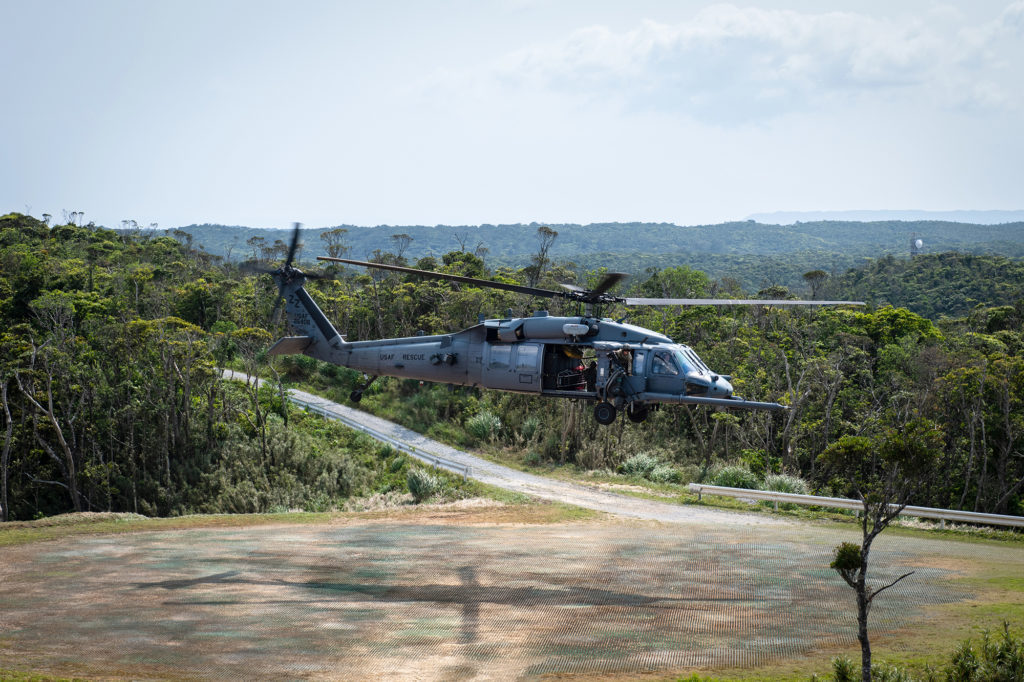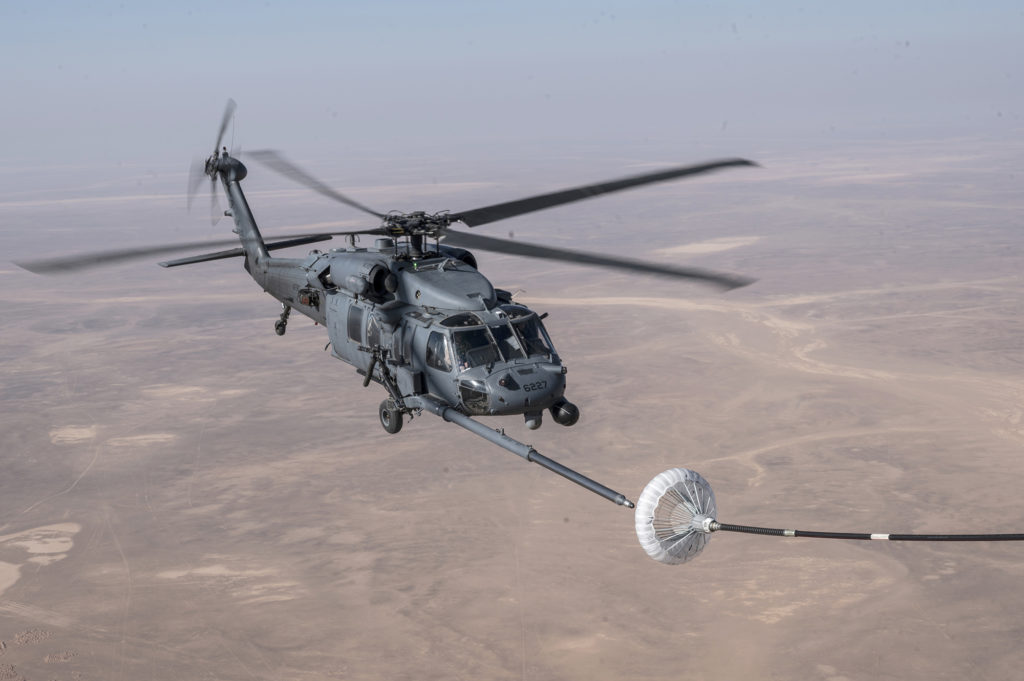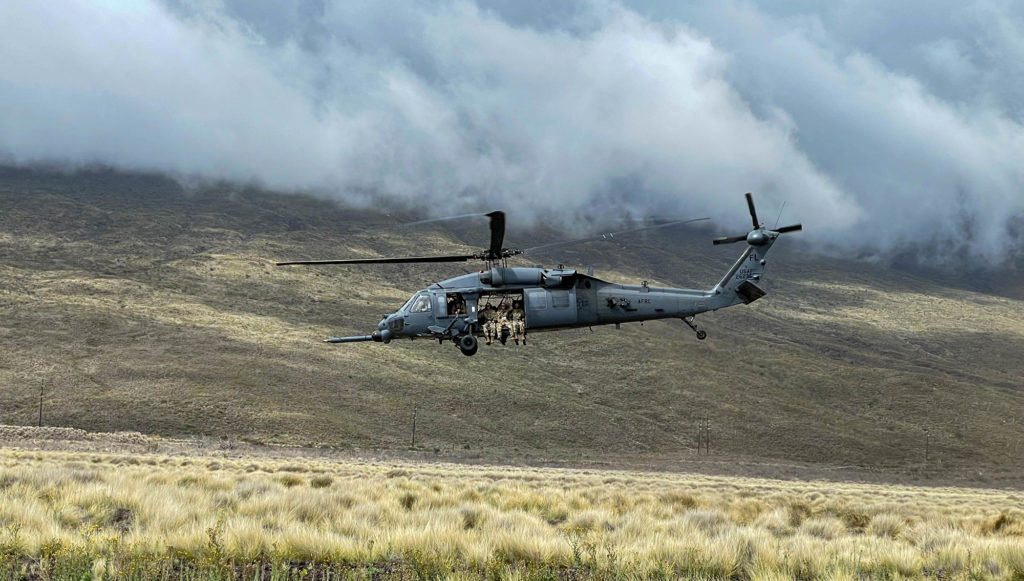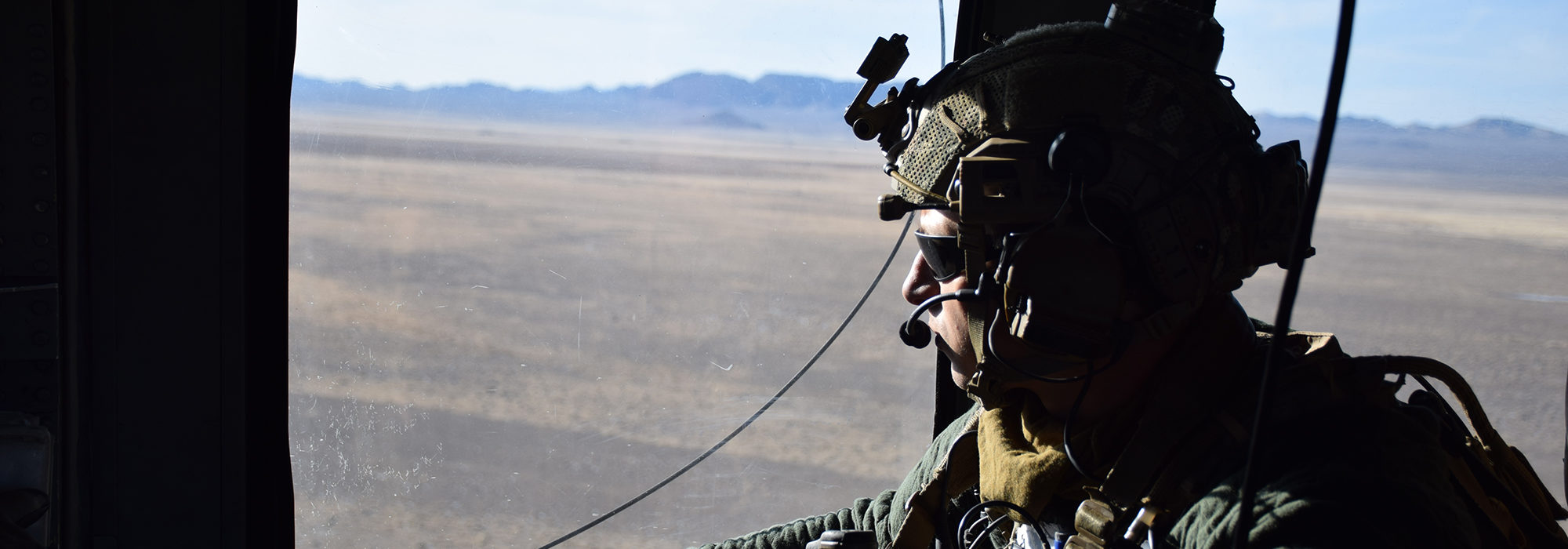Think Combat Search and Rescue Is No Longer Viable? These Air Force Rescue Pilots Say, ‘Think Again.’
It seemed like any Air Force rescue mission over the past 20 years: Two HH-60G Pave Hawk helicopters flying low over the desert to rescue someone on the ground, while a pair of A-10 Warthogs circled overhead for close air support and an HC-130J handled command and control.
Operating at the Nevada Test and Training Range in February, these rescuers were in training, part of a simulated air war that included friendly “blue” forces taking on hostile “red” aircraft and simulated surface-to-air threats as part of Red Flag 23-1. Their part was all about “how we fight underneath the big air war as it is going on, and how we still execute personnel recovery in a highly defended and threatened environment,” said Capt. Timothy Turner, a pilot with the 55th Rescue Squadron.
The Air Force has flown its Pave Hawks hard over the past 20 years in counterinsurgency conflicts in Iraq, Afghanistan, and elsewhere. But in those fights, the enemy didn’t have its own airpower, which won’t be the case if the U.S. finds itself in conflict with China or Russia, both of which have advanced fighters and surface-to-air missile systems.
“When we were doing counterinsurgencies, and we were losing pilots in those kinds of situations, the needs were different,” noted Air Force Secretary Frank Kendall in 2022 after deciding to cut back on the number of search and rescue helicopters the Air Force would buy to replace the Pave Hawk fleet. Kendall signed off on cutting the planned purchase of HH-60W Jolly Green II helicopters at 75, rather than 113 as originally planned, before Congress later pushed the total up to 85.
HH-60G Weapons Officer Lt. Col. Brandon LosackerThe Air Force has entered into a circular argument … they have decided the helicopter is not survivable, so have underinvested … their viewpoint of it not being survivable appears true.
“There are some places where you’re just not going to take a helicopter,” Kendall said in a Defense News interview. “It’s just not going to work with that reality.”
Air Force planners worry that low-flying, slow, non-stealthy helicopters are easy targets for integrated air defense systems, and they lack the range to bridge the vast stretches of ocean in the Indo-Pacific theater. But rescue Airmen say those problems are not insurmountable.

“If you’re Day One in the Taiwan Straits, that’s going to be a pretty hairy place to be operating,” said Lt. Col. Michael Kingry, an HH-60 weapons officer and National Defense Fellow at AFA’s Mitchell Institute for Aerospace Studies on Mitchell’s Aerospace Advantage podcast. “But likewise, there’s not some magical line out there in the western Pacific that, if you cross over and you’re not fifth-generation, you automatically burst into flames.”
Indeed, rescue Airmen argue that with the right equipment, HH-60Ws can be effective as scouts, communications relays, transports, weapons platforms, and ambulances in Pacific operations. But they need more support and less bureaucracy to bring that potential to the fight. The platform can still be upgraded, they say.
“Why don’t I put rockets and missiles and nonkinetics on my helicopter?” asked Lt. Col. Brough McDonald, HH-60G weapons officer and commander of the 305th Rescue Squadron, in an interview with Air & Space Forces Magazine. “The helicopters and the rescue fleet writ large have an opportunity to maximize the lethality and the survivability of the Combat Air Force as a whole. So it’s not just fighters protecting me, it’s—‘What can I do for fighters?’”
No Ocean Wide Enough
Distance is a familiar problem for rescue Airmen, who have plucked people off of ships hundreds of miles from shore and covered areas the size of the U.S. Atlantic Coast on East African deployments.
Even fighter jets need aerial refueling to cross the vast empty spaces of the Pacific, said HH-60G Weapons Officer Lt. Col. Brandon Losacker. Though the HH-60W has a much shorter unrefueled combat radius than fighters, helicopters do not need a runway to land, which means operators can set up shop almost anyplace among the thousands of islands in the western Pacific.
“This gives us an agility over distance that complements the larger air campaign,” Losacker said. “Anywhere you have a rock outcropping above the surface of the ocean that’s big enough to land an HH-60, you have a viable alert location.”
Rescue Airmen have a history of rescuing service members in the face of anti-aircraft threats. During the Vietnam War, radar-guided anti-aircraft artillery, surface-to-air missiles, and small arms fire at close range were all real threats, yet Airmen still managed to rescue 3,883 people leveraging their highly honed skills, “technological advances, innovation and imagination,” wrote historian Earl Tilford Jr. in his 1992 “Search and Rescue in Southeast Asia” history book.
Even today, McDonald pointed out that the threats facing a strike aircraft on the way to a target are not the same threats a helicopter faces on the way to rescuing a survivor. For example, a surface-to-air threat designed to target fast jets is not optimized for slow helicopters, and enemy aircraft likely will not be hanging around by the time a rescue helicopter shows up.
“I need to go to where the pilots jumped out of their airplane,” McDonald said. “That’s a different problem than the beaches of China on night one.”
Not So Alone, Not So Afraid
Because no aircraft can do everything all on its own, the Air Force uses force packages of other aircraft to cover all the blind spots. At Red Flag, fighters provided close air support and others handled command and control, while the down-and-dirty rescue operation fell to the HH-60s.
“People see how rescue has done it for 20 years, which is a totally different conflict than what we were simulating at Red Flag,” Turner said. “We probably can’t do it alone and unafraid. We need to fit under that umbrella of the full United States Air Force, this big team game.”
Still, helicopter crews have tricks to deal with advanced threats. “I’m not low-observable, but I fly really low, which is different,” said McDonald. “Your advanced modern long-range SAMs, their factor threat is a fighter going above the speed of sound up at high altitude. It’s not optimized for my helicopter going the speed of a nice motorcycle at or below treetop level.”
In fact, Air Force rescue helicopter crews intentionally train against America’s most advanced radars to maximize their survivability, McDonald said. The Jolly Green II’s improved radar warning receiver suite delivers more information faster to the crew, accelerating their decisions and giving them an edge over an adversary.

Yet the new HH-60Ws could be enhanced further. Laser jammers could defeat infrared-guided threats, and podded electronic countermeasures could disrupt adversary communications and help hide the helicopter in radio clutter. The Air Force built the HH-60W without external hardpoints for that equipment, which Losacker called “a critical design oversight.” But hardpoints could be added to support such equipment.
“We are not pursuing innovative ways to use the technology we have, with relatively cheap improvements, to increase the survivability of the platform we’re fielding,” Losacker said. “There’s a lot we’re leaving on the table.”
‘Approach This Like Airmen’
Air Force officials believe 85 Jolly Green IIs provide sufficient rescue capability.
“The Air Force is committed to supporting personnel recovery to the joint force by providing the Department of Defense’s only dedicated combat search and rescue force,” said Air Force spokesperson Ann Stefanek. “As the Department pivots to peer adversaries, the Air Force was forced to make a difficult prioritization decision, but the Air Force believes the planned fleet of 85 aircraft will provide the necessary capabilities for the future. We built our future force based on what we would need in a conflict with near-peer competitors.”
To prepare for a different kind of war, the Air Force is exploring how to train pilots to survive on their own for extended periods as they make their way to less-contested pick-up locations. The service is also on the hunt for autonomous electric vertical takeoff and landing (eVTOL) aircraft, that could potentially rescue downed aviators without putting other Airmen at risk.
But uncrewed rescue vehicles might not be able to pick up injured pilots, and it may be years before an eVTOL platform is considered reliable enough for such a mission.
“The only thing today is this Whiskey,” said McDonald. “That’s all you’ve got. So saying ‘well it’s not survivable’ … does that mean you are just not going to have any viable rescue aircraft for 20 years or more?”
Podded electronic countermeasures, lightweight guided rockets and laser jammers could be just the beginning of capabilities that would help HH-60Ws mitigate advanced threats.
“What if you unlock the innovation engine that is the Air Force and approached this like Airmen: make this airplane survivable against the J-20, the SA-20,” McDonald said. “Hey weapons officers, come up with tactics. Hey engineers, innovate and get creative. I think you would be like, ‘Whoa, we’ve got something here.’”
Rhyming With the Past
For Losacker, the issue isn’t that the aircraft can’t do the mission, it’s that the Air Force hasn’t equipped it to be as effective as it possibly can be. “The Air Force has entered into a circular argument in the sense they have decided the helicopter is not survivable, so have underinvested in its survivability, which thereby ensures their viewpoint of it not being survivable appears true,” he said.
The rescue community has seen this pattern before. After the Korean War, the Air Force cut the rescue service from 12,000 Airmen to 1,465, believing that nuclear wars would not require conventional rescue, Losacker noted in a published Air University paper in 2019. The Air Force then scrambled to rebuild the rescue service over the course of the Vietnam War, only to again let it atrophy as it contemplated war with the Soviet Union, Losacker wrote.
“I said, ‘Wait a minute. You’re killing the rescue service,’” one officer recalled about the Air Force Council decision not to buy the HH-60 for the rescue program in the mid-1980s, as featured in the book Combat Search and Rescue in Desert Storm. “And the guy said, ‘If we put all that money into the H-60, there won’t be any money to buy fighters so there won’t be any fighter pilots to rescue.’ … So there was no [HH-60].”
The Air Force purchased MH-60Gs for special operations starting in 1982, then later fielded HH-60Gs for search and rescue. Now as the Pave Hawk fleet is nearing end of life, its replacement is getting a similar pinch.
“There is a strong body of thought within the Air Force that any future war with a peer adversary will be so deadly CSAR will not be executable,” Losacker wrote in 2019. But, he argues, “we are obligated to posture rescue to come to the aid of our Airmen.”
The budget math is difficult to justify when CSAR is thought of as an expensive insurance policy, McDonald said. “If it’s an insurance value proposition, it doesn’t make sense,” said McDonald. “If there’s $1 on the table, do you make a jet that can’t be shot down or do you not make that jet and buy rescue forces to go get them?”
Rather than insurance, McDonald suggested thinking of CSAR as a versatile, airpower-enabling element of the Air Force’s force-packaging system. Helicopters can serve as “antenna farms” relaying information to fixed-wing assets from within the red threat rings of enemy missiles; they can provide fire support in defense of austere bases; and they can assist in mass casualty response, as they did in Iraq during the 2020 Iran missile attack. Air Force rescue helicopters have proven their multi-role capabilities in for decades in the U.S. Central Command area of operations, including recently while the command serves as a test lab for Agile Combat Employment, McDonald pointed out.
‘We Need a Decision’
The rescue motto—“These things we do, that others may live”—is something rescue Airmen take to heart.
“We’re not going to leave somebody out there,” said Turner. “If it didn’t happen today, we will try again tomorrow and the day after. We are always going to continue to try, and we take pride in that.”
The Army doesn’t send infantry into combat without medics, and the Marines don’t deploy without corpsmen, Losacker said. So it should be, he added, for the Air Force: Fighter pilots should not be expected to fight China without rescue Airmen who have their backs.

“If our leadership’s assessment is that rescue as a community is not viable, then what?” Losacker asked. “If not us, then who?”
One idea to move faster on future CSAR operating concepts could a rescue and attack combat unit that would have the funding and authority to explore experimental technologies, including eVTOL aircraft, that can be tried and tested in major exercises to accelerate development and bypass years of testing.
“If we want to increase speed-to-need, then there has to be a deliberate decision to accept greater risk,” said Losacker, who believes risk can be mitigated by selecting very mature, experienced aviators for such a unit.
“My community, they don’t know how to lose, and they don’t accept it,” said McDonald. “If we give them baling wire and bubble gum, they’re going to figure it out, because that’s just who we are. I think I anguish over it because I look at the taskings and the requirements and what we think the peer fight is going to look like and result in, and in spite of that, you want to shorten the buy?’”
The Air Force budget strategy is built around inflicting casualties on adversaries, but Losacker insists the service must commit to a rescue plan in order to minimize American casualties and protect downed aircrew.
“A key indicator a nation is very serious about preparing for a war is when they move field hospitals and blood supplies to support the front,” he said. “The analogy holds for air war. Everything is empty saber-rattling with little true deterrence until you show you’re ready and willing to get bloody.”
